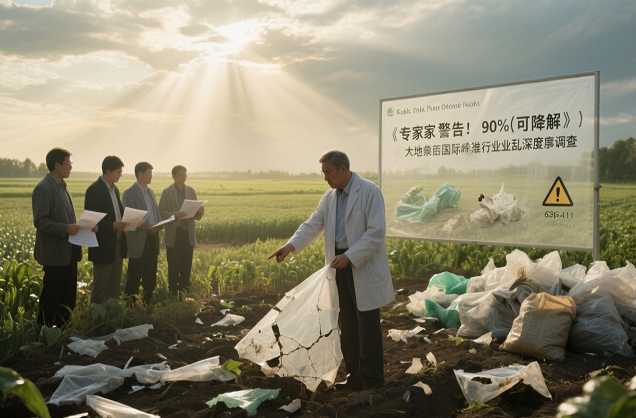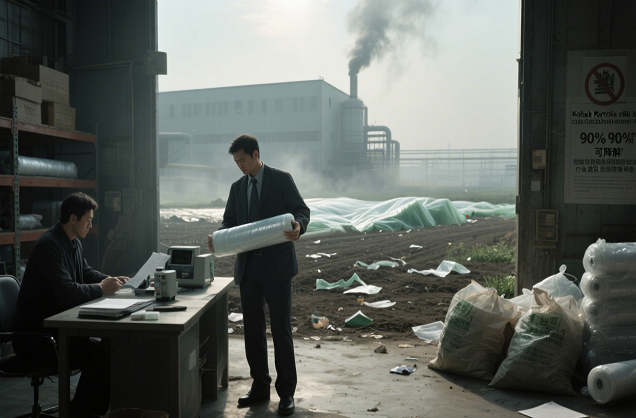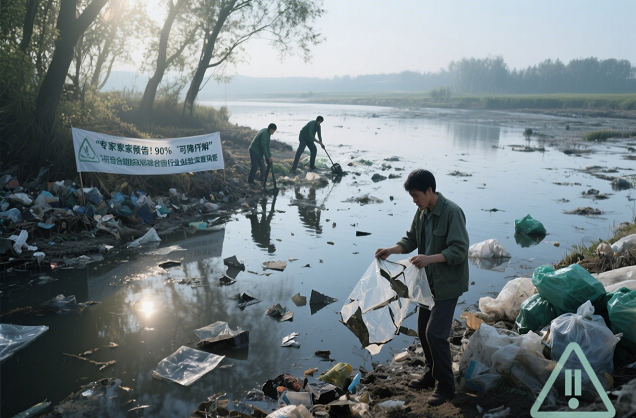Expert warning: 90% of 'biodegradable' mulch actually does not meet international standards! An in-depth investigation into the industry's chaos
In 2024, the Ministry of Agriculture's sampling data showed that 87.6% of agricultural films labeled as “biodegradable” on the market failed to pass international standards. This alarming data reveals the serious problem of confusing standards in the biodegradable film industry.

I. The great divide between international standards and market realities
1. Core international standard requirements (ISO 23517/EN 13432)
Biodegradation rate: ≥90% within 180 days
Ecotoxicity: the degradation product's influence on plant germination rate ≤ 10%
Heavy metal content: cadmium (Cd) ≤ 0.5mg/kg, lead (Pb) ≤ 50mg/kg
Degradation time: ≤2 years under standard composting conditions.
2. Comparison of sampling results in China market (Q1 2024)
Test item Compliance rate Typical problems
Biodegradation rate 12.4% Most of them are only 40-60%.
Heavy metal exceeds the standard 31.7% Lead content up to 200mg/kg
Microplastic residue 68.3% Fragments remain after 3 months
False labeling 45.2% Falsification of certification marks
II. Three Typical Disorders of Pseudo-degradable Mulch
1. “Adulterated” degradation (accounting for 62% of the products in question)
Common practice: PE + 30% starch + photosensitizer
Actual performance: only starch partially degradation of PE matrix to form more dangerous microplastics
Chinese Academy of Agricultural Sciences test shows: soil microplastic content increased by 3 times after use
2. “Oxidative” degradation (28% of the products in question)
Typical formula: PP + oxidative degradation additives
Fatal flaw: only cleaves to plastic particles, does not comply with ISO, definition of true biodegradation EU has legislated against (Directive 2019/904)
3. “Certification fraud” (10% of products in question)
Black and gray industry chain: buy expired certifications ($200-500/copy), PS modified test reports, fictitious European subsidiaries to obtain EN13432 certification

III. The four major hazards of poor-quality mulch
1. Increased soil pollution
Accumulation of microplastics: annual residue of up to 2.3 kilograms per mu of land
Heavy metal risk: excessive film leads to cadmium content in vegetables exceeds the national standard by 5 times.
2. Economic loss of farmers
False function propaganda: promised “3 months degradation” actually need more than 5 years
Shandong case: 200 mu greenhouses lost 30% of production due to residual film.
3. Damage to the recycling system
Mixed pollution: pseudo-degradable film makes compost products with plastic content exceeding the standard.
Sorting cost: 800 yuan per ton of recycled material processing fee increases.
4. Crisis of trust in the industry
Prices of products of regular enterprises were lowered by 25-40%.
European importers' rejection rate of Chinese degradable film rises to 50%.
IV. Authoritative identification guide (with practical methods)
1. Laboratory-level detection means
Infrared spectroscopy (FTIR): detection of PE / PP characteristic peaks (2915cm-¹, 2848cm-¹)
Thermogravimetric analysis (TGA): complete decomposition of real PLA at 300-350°C
Composting test: Verification of degradation rate according to ISO 14855 standard
2. Quick identification techniques on site
Methods True degradation film performance False degradation film performance
Burning test: light smoke, waxy smell, black smoke, pungent plastic smell.
Hot water immersion (80℃) Edges gradually soften and dissolve Only soften and not dissolve
Soil burial observation 3 months, obvious thinning, no change in appearance.
Verification of certification mark Invalid or expired number can be checked on the official website.
3. Procurement checklist
The latest valid EN13432/ASTM D6400 certification.
Full-component analysis report from third-party organization
Actual field test data (≥3 growing seasons)
Manufacturer's quality indemnity commitment

V. Industry consolidation and policy direction
1. Latest Regulatory Developments
China: Mandatory National Standard for Fully Biodegradable Mulch (GB/T 35795-2023) to be Implemented from July 2024
EU: Digital Passport System for Biodegradable Products to be Established (2025 Trial)
U.S.: EPA proposes to penalize pseudo-biodegradable films as “false environmental propaganda”.
2. Response measures of leading enterprises
JDF: Launched blockchain traceability system, scanning code to view full life cycle data.
BASF: Opened degradation testing platform for customer verification.
Sinochem Agriculture: 200 demonstration farms established to conduct comparative trials

VI. Recommendations for different stakeholders
1. Procurement Guidelines for Farmers
Price warning line: the cost of true degradable film ≥ 2 times of ordinary film
Preferred choice: products that have been insured with quality insurance.
Rights defense channel: 12315 platform added “agricultural counterfeiting” special
2. Dealer risk avoidance
Require manufacturers to provide bank performance bond
Leave 3kg of samples per batch for inspection
The contract explicitly exceeds the standard compensation provisions (recommended ≥ 3 times the purchase price)
3. Transformation path for manufacturers
Immediately stop the production of oxidative degradation products
Invest in PLA/PBAT modification research and development.
Participate in the development of group standards to enhance the right to speak
 For PLA/PBAT biodegradable mat
For PLA/PBAT biodegradable mat
 Price war! PBAT raw material p
Price war! PBAT raw material p
 PBAT degradation speed increas
PBAT degradation speed increas
 From Policy to Practice: Impli
From Policy to Practice: Impli
CONTACT
Add: Room 4006, No.1 Helong Yiheng Road, Baiyun District, Guangzhou City
Tel: +8613450255948
Wechat : +86-13450255948
Fax: +86-13450255948
E-mail: 13450255948@163.com








